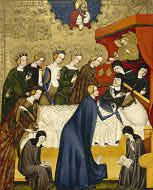
|
Master of Heiligenkreuz (artist) Austrian, active early 15th century The Death of Saint Clare, c. 1400/1410 oil on panel painted surface: 66.3 x 54 cm (26 1/8 x 21 1/4 in.) support: 67.5 x 55.3 cm (26 9/16 x 21 3/4 in.) framed: 85.7 x 74.3 x 5.7 cm (33 3/4 x 29 1/4 x 2 1/4 in.) Samuel H. Kress Collection 1952.5.83 |
Object 1 of 8
Saint Clare was a disciple of Saint Francis and founder of the order of Franciscan nuns called the Poor Clares. This jewellike painting illustrates a vision that appeared to her followers as they stood vigil around her deathbed in 1253. The Virgin cradles the dying nun's head as a group of female saints, Clare's sister Agnes, and members her order stand by. Above the gold field that separates earth from heaven, Jesus holds a representation of Clare's soul as a white-clad child. (The gold leaf, often beaten from coins, was applied in extremely thin square sheets whose overlapping outlines are visible here.)
This panel was perhaps made for a convent of the Poor Clares in eastern Europe. We do not know the name or even the nationality of the artist, but his style is unmistakable, distinguished by large heads, long spidery fingers, saturated colors, and richly patterned surfaces. The long, elegantly silhouetted figures, delicate designs punched into the gilt, and flattened space are all typical of the International Style, a court style that united the arts from Paris to Prague at the end of the Middle Ages. Its surprising uniformity resulted from dynastic marriages and from the strong competition between royal patrons to hire the best artists. Speculation about this artist—he has been called French, German, Austrian, and Bohemian—indicates the style's pervasiveness.
| « | back to gallery | » | continue tour |


